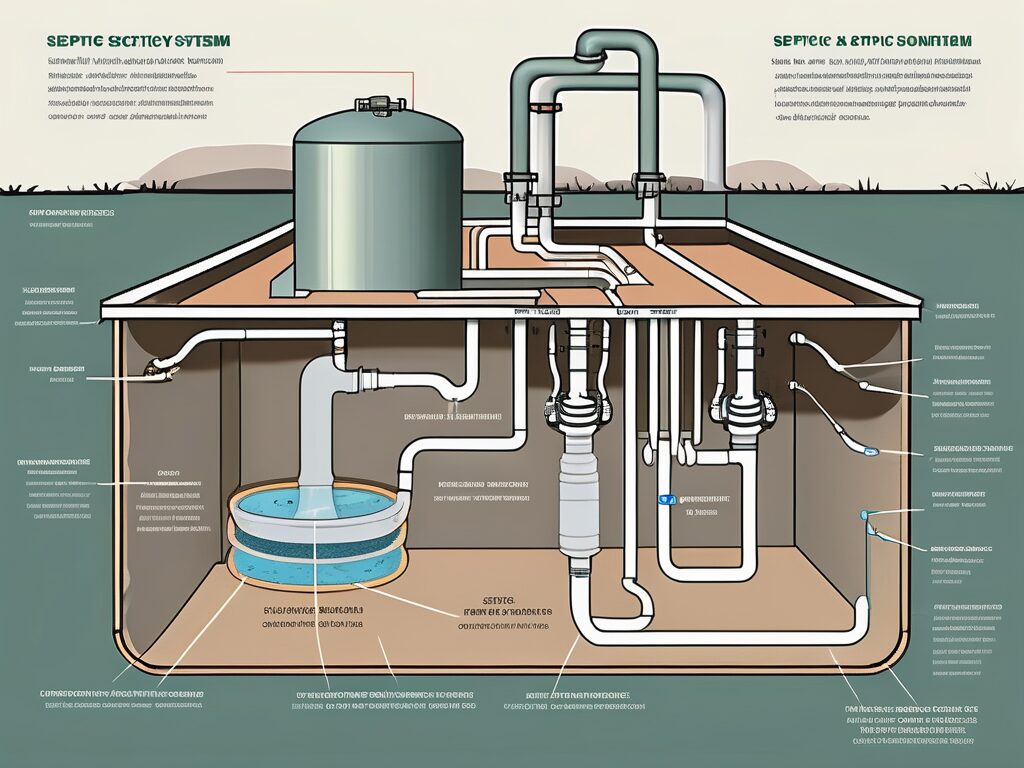
Agent A-Team or Solo Superhero? Finding the Right Real Estate Partner for Your Selling Journey in Wildwood Florida
When it comes to selling your home in Wildwood, Florida,…
January 29, 2024
Septic systems are an integral part of many homes, yet they often go unnoticed until a problem arises. Understanding how your septic system works is essential for its proper maintenance and upkeep. In this comprehensive guide, we will delve into the inner workings of septic systems, shed light on septic tank inspections, and explore common findings and repair costs. By the end, you will have a clear understanding of how to not only care for your septic system but also identify potential issues before they become major headaches.
Before we dive into the specifics of septic inspections, let’s first uncover the basics of how a septic system operates. When wastewater flows from your home through the drain pipes, it enters the septic tank, where solid waste settles at the bottom and forms a layer of sludge. The liquid waste, known as effluent, then flows into the drain field, where it is further treated by the soil.
A septic system relies on a delicate balance of biological processes to break down the organic matter in the wastewater. The role of bacteria is crucial in this decomposition process, as it helps in the breakdown of organic solids and the treatment of harmful pathogens. Maintaining a healthy bacterial population within your septic system is vital for its proper functioning.
Now, let’s take a closer look at the septic tank itself. Typically made of concrete or fiberglass, the septic tank is designed to hold and separate the solid waste from the liquid waste. As the wastewater enters the tank, it undergoes a process called primary treatment. During this stage, the heavier solids settle at the bottom of the tank, forming a layer of sludge, while the lighter materials, such as fats and oils, float to the top, creating a layer of scum. The middle layer, known as the clarified liquid, is the effluent that will eventually flow into the drain field.
Inside the septic tank, anaerobic bacteria thrive in the oxygen-deprived environment. These bacteria play a vital role in breaking down the organic matter in the sludge and scum layers. Over time, the bacteria convert the solid waste into simpler compounds, such as carbon dioxide and methane gas. This natural decomposition process reduces the volume of the sludge and scum layers, allowing the septic tank to function efficiently.
Once the effluent leaves the septic tank, it enters the drain field, also known as the leach field or absorption field. This area consists of a network of perforated pipes buried in trenches filled with gravel or other porous materials. The effluent is distributed evenly across the drain field, where it percolates through the soil. The soil acts as a natural filter, removing any remaining impurities and pathogens from the wastewater.
The drain field relies on aerobic bacteria, which require oxygen to thrive. These bacteria further break down any organic matter present in the effluent, ensuring that the wastewater is properly treated before it reaches the groundwater. The soil’s composition and permeability play a crucial role in the effectiveness of the drain field. It should be well-drained to prevent any potential issues, such as waterlogging or contamination.
Regular maintenance and proper usage are essential for the longevity and efficiency of a septic system. Regular pumping of the septic tank is necessary to remove accumulated sludge and scum, preventing them from clogging the drain field. Additionally, being mindful of what goes down the drains can help prevent excessive buildup and potential system failures. Avoiding the disposal of non-biodegradable items, chemicals, and excessive amounts of fats and oils can help maintain a healthy bacterial population and prevent clogs.
Welcome to the world of septic tank inspections, where the mysteries of your underground waste management system are brought to light. Regular inspections are not just a formality, but a crucial step in ensuring the longevity and efficiency of your septic tank. By identifying potential issues early on, you can prevent costly repairs and keep your system running smoothly for years to come.
So, what can you expect during a septic tank inspection? Let’s dive into the details.
When a qualified professional arrives at your property for a septic tank inspection, they come armed with knowledge and expertise to assess various components of your system. Their goal is to ensure that everything is in proper working order and to detect any red flags that may require attention.
The inspection process typically involves a comprehensive examination of your septic tank and its surroundings. Here’s a breakdown of the key steps:
Now that you have a general idea of what to expect during a septic tank inspection, let’s take a closer look at the key features that will be thoroughly inspected:
By thoroughly inspecting these key features, the septic tank inspector leaves no stone unturned in their quest to ensure the optimal performance of your septic system. So, the next time you schedule a septic tank inspection, rest assured that you are taking a proactive step towards the long-term health and functionality of your underground waste management system.
One common finding during septic inspections is damaged walls within the septic tank. Over time, the corrosive nature of the wastewater can cause deterioration or cracks in the concrete or other tank materials. This can lead to leaks and potential contamination of the surrounding soil and groundwater. Repairing damaged walls may involve patching the cracks or even replacing the tank if the damage is severe. The cost of repairing damaged walls in a septic system can vary depending on the extent of the damage and the materials used for repair. It is important to address this issue promptly to prevent further damage and ensure the proper functioning of the septic system.
When repairing damaged walls in a septic tank, it is crucial to consider the long-term durability of the repair. Using high-quality materials and following proper repair techniques can help extend the lifespan of the septic tank and minimize the need for future repairs. Additionally, regular maintenance and inspections can help identify any potential issues with the septic system before they become major problems.
Another issue that may arise during septic inspections is a faulty distribution box (D-box). The D-box is responsible for evenly distributing effluent to the drain field pipes. If the D-box is damaged or clogged, it can lead to uneven distribution, resulting in certain areas of the drain field becoming overloaded. This can cause the drain field to fail, leading to sewage backups and potential health hazards.
Repairing a faulty D-box usually involves replacing the damaged unit. The cost of replacing a D-box can vary depending on the size and type of the box, as well as the labor involved in the installation. It is important to address this issue promptly to prevent further damage to the drain field and ensure the proper functioning of the septic system.
In addition to repairing or replacing the D-box, it is important to identify and address the underlying cause of the issue. Common causes of D-box problems include improper installation, tree root intrusion, and clogs caused by solid waste or debris. Taking steps to prevent these issues, such as regular maintenance and inspections, can help prolong the lifespan of the D-box and the overall septic system.
Pump failures can occur in septic systems that use a pump to transport effluent from the tank to the drain field. A malfunctioning pump can disrupt the flow of wastewater, potentially causing backups and other issues. Pump failures can be caused by various factors, including electrical problems, mechanical failures, and improper maintenance.
Depending on the severity of the pump failure, repairs may involve replacing damaged components or even installing a new pump. The cost of repairing or replacing a septic pump can vary depending on the type and size of the pump, as well as the labor involved in the installation. Regular maintenance and inspections can help identify any potential issues with the pump and prevent pump failures.
In addition to addressing the immediate pump failure, it is important to identify and address the underlying cause of the issue. Common causes of pump failures include power outages, excessive water usage, and improper pump sizing. Taking steps to prevent these issues, such as installing a backup power source and properly sizing the pump, can help prevent future pump failures and ensure the proper functioning of the septic system.
Invasive tree roots can pose a significant problem for septic systems, as they can penetrate pipes and cause blockages. During a septic inspection, roots may be detected through the presence of clogs or evidence of water infiltration. Addressing invasive roots often requires professional root removal and, in some cases, repairing or replacing affected pipes.
The cost of addressing invasive roots in a septic system can vary depending on the extent of the root intrusion and the necessary repairs. In some cases, it may be necessary to excavate the affected area and replace the damaged pipes. Preventive measures, such as planting trees away from the septic system and regularly maintaining the surrounding vegetation, can help minimize the risk of root intrusion.
It is important to address invasive roots promptly to prevent further damage to the septic system. In addition to causing blockages, invasive roots can also cause leaks and structural damage to the pipes, leading to costly repairs. Regular inspections and maintenance can help identify and address root intrusion before it becomes a major problem.
Septic systems are designed to accommodate the wastewater volume generated by a specific number of occupants in a household. However, if the system was not properly sized or has undergone modifications without considering the increased demand, it may become overwhelmed. This can lead to issues such as sewage backups, drain field failures, and contamination of the surrounding environment.
A thorough septic inspection can help determine whether your system is adequate for your home’s needs or if modifications are necessary. This involves evaluating the size of the septic tank, the drain field capacity, and the overall system design. If the inspection reveals that the system is undersized or inadequate, it may be necessary to upgrade the septic system to ensure proper functionality.
The cost of upgrading a septic system can vary depending on the specific modifications required. This may include installing a larger septic tank, expanding the drain field, or adding additional components such as a pump or a D-box. It is important to consult with a professional septic system designer or installer to determine the most appropriate and cost-effective solution for your specific needs.
Baffles in septic tanks play a crucial role in preventing solids from escaping into the drain field and ensuring proper wastewater flow. During an inspection, the baffles’ condition and functionality will be evaluated. If the baffles are damaged, deteriorated, or missing, repairs or replacements will be necessary to avoid potential system failure.
Repairing or replacing damaged baffles in a septic tank is essential to maintain the proper functioning of the septic system. The cost of repairing or replacing baffles can vary depending on the materials used and the labor involved. It is important to address this issue promptly to prevent solids from entering the drain field, which can lead to clogs and system failures.
In addition to repairing or replacing damaged baffles, it is important to properly maintain the septic tank to prevent future issues. This includes regular pumping to remove accumulated solids and avoiding the disposal of non-biodegradable materials in the septic system. Regular inspections can help identify any potential issues with the baffles and ensure the long-term functionality of the septic system.
A healthy population of bacteria is essential for the efficient breakdown of organic matter in your septic system. During an inspection, the inspector may test the bacterial activity within the tank. If the bacterial levels are low, the inspector may recommend introducing bacteria additives to enhance the system’s performance.
Bacteria additives can help replenish the bacterial population in the septic tank and improve the breakdown of organic matter. The cost of bacteria additives can vary depending on the brand and type of product. It is important to follow the manufacturer’s instructions when using bacteria additives to ensure proper dosage and application.
In addition to using bacteria additives, it is important to maintain a septic-friendly lifestyle to promote a healthy bacterial population. This includes avoiding the use of harsh chemicals, limiting water usage, and properly disposing of waste. Regular inspections and maintenance can help ensure the optimal bacterial activity in the septic system and prevent issues such as clogs and system failures.
Drain field issues can cause a range of problems, from swampy areas in your yard to sewage backups in the house. During a septic inspection, the inspector will assess the drain field’s overall condition, including signs of saturation, standing water, or foul odors. Depending on the issues identified, solutions may involve improving drainage, aerating the soil, or, in extreme cases, replacing the drain field.
The cost of addressing drain field issues can vary depending on the specific problems and the necessary solutions. This may include installing additional drain field lines, improving the soil’s drainage capacity, or replacing the drain field entirely. It is important to address drain field issues promptly to prevent further damage to the septic system and the surrounding environment.
Preventive measures, such as regular inspections and proper maintenance, can help identify and address drain field issues before they become major problems. This includes avoiding the disposal of non-biodegradable materials in the septic system, limiting water usage, and properly maintaining the drain field area.
Septic tank drainage problems can manifest as slow drains, gurgling sounds from plumbing fixtures, or backups in the house. During an inspection, the inspector will investigate potential causes of drainage issues, such as clogged pipes or a full septic tank. Addressing these problems promptly is crucial to prevent further damage and restore proper system functionality.
The cost of troubleshooting and repairing septic tank drainage problems can vary depending on the specific issues and the necessary repairs. This may include removing clogs, pumping the septic tank, or repairing damaged pipes. It is important to consult with a professional septic system technician to accurately diagnose the problem and determine the most appropriate solution.
In addition to addressing the immediate drainage problem, it is important to identify and address the underlying cause to prevent future issues. This may involve modifying usage habits, such as avoiding the disposal of non-biodegradable materials and limiting water usage. Regular inspections and maintenance can help prevent drainage problems and ensure the proper functioning of the septic system.
In conclusion, understanding how your septic system works is essential for maintaining its health, longevity, and efficient operation. Regular septic tank inspections are vital for identifying potential issues early on and ensuring the necessary repairs or modifications are made. By following this complete guide, you can be confident in your ability to care for your septic system and keep it running smoothly for years to come.

If you want the Richr team to help you save thousands on your home just book a call.
 Book a call
Book a call